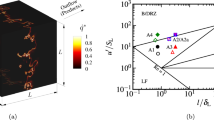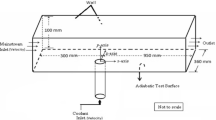Abstract
Computational Fluid Dynamics (CFD) results are discussed for momentum driven planar jet flows, resembling configurations in use for air curtain in the context of smoke control in building fire. The CFD package Fire Dynamics Simulator (FDS) is used. Special focus is given to the impact of grid resolution, synthetic turbulent inflow boundary condition and sub-grid scale eddy viscosity models. The computational results are compared with summarized literature data. Investigation of different set-ups of inlet boundary conditions, including the inlet duct length, velocity profile and method of generation of turbulence at the level of the inflow, reveals that the inlet boundary condition is the most influential factor governing the flow downstream. The FDS results successfully reproduce the planar jet flows, both in terms of mean variables and second-order statistics. ‘Reference’ results have been obtained with a fully developed turbulent flow emerging from a long inlet duct. By reducing the inlet duct length and applying the Synthetic Eddy Method (SEM) at the inflow boundary condition, the ‘reference’ results have been reproduced with a reduction in the computing times of approximately 20%. However, care must be taken when choosing the parameters of SEM, in particular the number of eddies and their length scale. The impact of turbulent viscosity model is noticeable, but not of primary importance for the flow at hand, provided that a sufficiently fine computational mesh is used.


















Similar content being viewed by others
References
Schlichting H (1933) Laminare strahlausbreitung. ZAMM 13(4):260–263
Forthmann E (1936) Turbulent jet expansion. National Advisory Commitee for Aeronautics, Washington
Bradbury L (1965) The structure of a self-preserving turbulent plane jet. J Fluid Mech 23(01):31–64. https://doi.org/10.1017/S0022112065001222
Heskestad G (1965) Hot-wire measurements in a plane turbulent jet. J Appl Mech 32 (4):721–734. https://doi.org/10.1115/1.3625158
Gutmark E, Wygnanski I (1976) The planar turbulent jet. J Fluid Mech 73 (03):465–495. https://doi.org/10.1017/S0022112076001468
Rajaratnam N (1976) Turbulent Jets. Elsevier Scientific Publishing Company
George WK (1989) The self-preservation of turbulent flows and its relation to initial conditions and coherent structures. In: Advances in Turbulence, pp 39–73
Deo RC (2005) Experimental investigations of the influence of Reynolds number and boundary conditions on a plane air jet. The University of Adelaide, Adelaide
Gouldin FC, Schefer RW, Johnson SC, Kollmann W (1986) Nonreacting turbulent mixing flows. Prog Energy Combust Sci 12(4):257–303. https://doi.org/10.1016/0360-1285(86)90004-3
Stanley S, Sarkar S, Mellado J (2002) A study of the flow-field evolution and mixing in a planar turbulent jet using direct numerical simulation. J Fluid Mech 450:377–407. https://doi.org/10.1017/S0022112001006644
Klein M, Sadiki A, Janicka J (2003) Investigation of the influence of the Reynolds number on a plane jet using direct numerical simulation. Int J Heat Fluid Flow 24 (6):785–794. https://doi.org/10.1016/S0142-727X(03)00089-4
Merci B, Dick E (2002) Predictive capabilities of an improved cubic k-epsilon model for inert steady flows. Flow Turbul Combust 68 (4):335–358. https://doi.org/10.1023/A:1021754324341
Berg JR, Ormiston SJ, Soliman HM (2006) Prediction of the flow structure in a turbulent rectangular free jet. Int Commun Heat Mass Transf 33 (5):552–563. http://dx.doi.org/10.1016/j.icheatmasstransfer.2006.02.007
Dai Y, Kobayashi T, Taniguchi N (1994) Large eddy simulation of plane turbulent jet flow using a new outflow velocity boundary condition. JSME Int J Ser B Fluids Therm Eng 37(2):242–253. https://doi.org/10.1299/jsmeb.37.242
Beaubert F, Viazzo S (2003) Large eddy simulations of plane turbulent impinging jets at moderate Reynolds numbers. Int J Heat Fluid Flow 24 (4):512–519. http://dx.doi.org/10.1016/S0142-727X(03)00045-6
Hu LH, Zhou JW, Huo R, Peng W, Wang HB (2008) Confinement of fire-induced smoke and carbon monoxide transportation by air curtain in channels. J Hazard Mater 156 (1–3):327–334. https://doi.org/10.1016/j.jhazmat.2007.12.041
Luo N, Li A, Gao R, Zhang W, Tian Z (2013) An experiment and simulation of smoke confinement utilizing an air curtain. Saf Sci 59 (0):10–18. https://doi.org/10.1016/j.ssci.2013.04.009
Yu L-X, Beji T, Zadeh SE, Liu F, Merci B (2016) Simulations of smoke flow fields in a wind tunnel under the effect of an air curtain for smoke confinement. Fire Technol 52 (6):2007–2026. https://doi.org/10.1007/s10694-016-0598-y
McGrattan K, McDermott R, Floyd J, Hostikka S, Forney G, Baum H (2012) Computational fluid dynamics modelling of fire. Int J Comput Fluid Dyn 26 (6-8):349-361. http://dx.doi.org/10.1080/10618562.2012.659663
McGrattan K, Hostikka S, McDermott R, Floyd J, Weinschenk C, Overholt K (2013) Fire dynamics simulator, user’s guide. NIST Special Publication 1019, 6th edn. National Institute of Standards and Technology, Gaithersburg, Maryland, USA, and VTT Technical Research Centre of Finland, Espoo, Finland. https://doi.org/10.6028/nist.sp.1019
Smagorinsky J (1963) General circulation experiments with the primitive equations: I. The basic experiment*. Mon Weather Rev 91(3):99–164. https://doi.org/10.1175/1520-0493(1963)091<0099:GCEWTP>2.3.CO;2
Moin P, Squires K, Cabot W, Lee S (1991) A dynamic subgrid-scale model for compressible turbulence and scalar transport (1989–1993). Phys Fluids A Fluid Dyn 3(11):2746–2757. https://doi.org/10.1063/1.858164
Germano M, Piomelli U, Moin P, Cabot WH (1991) A dynamic subgrid-scale eddy viscosity model (1989–1993). Phys Fluids A Fluid Dyn 3(7):1760–1765. https://doi.org/10.1063/1.857955
Deardorff JW (1972) Numerical investigation of neutral and unstable planetary boundary layers. J Atmos Sci 29(1):91–115. https://doi.org/10.1175/1520-0469(1972)029<0091:NIONAU>2.0.CO;2
McGrattan K, Hostikka S, McDermott R, Floyd J, Weinschenk C, Overholt K (2013) Fire dynamics simulator, technical reference guide, volume 1: mathematical model. NIST Special Publication 1018, 6th edn. National Institute of Standards and Technology, Gaithersburg, Maryland, USA, and VTT Technical Research Centre of Finland, Espoo, Finland. https://doi.org/10.6028/nist.sp.1018-1
Vreman A (2004) An eddy-viscosity subgrid-scale model for turbulent shear flow: algebraic theory and applications (1994-present). Phys Fluids 16(10):3670–3681. https://doi.org/10.1063/1.1785131
Jarrin N, Prosser R (2008) Synthetic inflow boundary conditions for the numerical simulation of turbulence. University of Manchester, United Kingdom
McGrattan K, Hostikka S, McDermott R, Floyd J, Weinschenk C, Overholt K (2013) Fire dynamics simulator, technical reference guide, volume 3: validation. NIST Special Publication 1018, 6th edn. National Institute of Standards and Technology, Gaithersburg, Maryland, USA, and VTT Technical Research Centre of Finland, Espoo, Finland. https://doi.org/10.6028/nist.sp.1018-1
Yu L-X, Beji T, Liu F, Weng M-C, Merci B (2017) Analysis of FDS 6 simulation results for planar air curtain related flows from straight rectangular ducts. Fire Technol. https://doi.org/10.1007/s10694-017-0690-y
Jenkins PE, Goldschmidt VW (1973) Mean temperature and velocity in a plane turbulent jet. J Fluids Eng 95(4):581–584. https://doi.org/10.1115/1.3447073
Browne LWB, Antonia RA, Rajagopalan S, Chambers AJ (1983) Interaction region of a two-dimensional turbulent plane jet in still air. In: Dumas R, Fulachier L (eds) Structure of complex turbulent shear flow: symposium, Marseille, France August 31–September 3, 1982. Springer Berlin Heidelberg, Berlin, Heidelberg, pp 411–419. https://doi.org/10.1007/978-3-642-81991-9_40
Hitchman G, Strong A, Slawson P, Ray G (1990) Turbulent plane jet with and without confining end walls. AIAA J 28(10):1699–1700. https://doi.org/10.2514/3.10460
Gordeyev S, Thomas F (2000) Coherent structure in the turbulent planar jet. Part 1. Extraction of proper orthogonal decomposition eigenmodes and their self-similarity. J Fluid Mech 414:145–194. https://doi.org/10.1017/S002211200000848X
Jarrin N, Benhamadouche S, Laurence D, Prosser R (2006) A synthetic-eddy-method for generating inflow conditions for large-eddy simulations. Int J Heat Fluid Flow 27(4):585–593. https://doi.org/10.1016/j.ijheatfluidflow.2006.02.006
Jarrin N, Prosser R, Uribe J-C, Benhamadouche S, Laurence D (2009) Reconstruction of turbulent fluctuations for hybrid RANS/LES simulations using a synthetic-eddy method. Int J Heat Fluid Flow 30(3):435–442. https://doi.org/10.1016/j.ijheatfluidflow.2009.02.016
McDonough JM (2007) Introductory lectures on turbulence: physics, mathematics and modeling. Mechanical engineering textbook gallery. 2. UKnowledge, University of Kentucky
Pope SB (2000) Turbulent flows. Cambridge University Press, Cambridge
Deardorff JW (1970) A numerical study of three-dimensional turbulent channel flow at large Reynolds numbers. J Fluid Mech 41(02):453–480. https://doi.org/10.1017/S0022112070000691
Piomelli U, Moin P, Ferziger JH (1988) Model consistency in large eddy simulation of turbulent channel flows. Phys Fluids 31(7):1884–1891. https://doi.org/10.1063/1.866635
Germano M, Piomelli U, Moin P, Cabot WH (1991) A dynamic subgrid-scale eddy viscosity model. Phys Fluids A Fluid Dyn 3(7):1760–1765. https://doi.org/10.1063/1.857955
Canuto V, Cheng Y (1997) Determination of the Smagorinsky–Lilly constant CS. Phys Fluids 9(5):1368–1378. https://doi.org/10.1063/1.869251
Turbulence Intensity – CFD-Wiki, The Free CFD Reference. (2016). http://www.cfd-online.com/Wiki/Turbulence_intensity. Accessed 20 Nov 2016
Merci B, Dick E, Vierendeels J, De Langhe C (2002) Determination of epsilon at inlet boundaries. Int J Numer Method H 12(1):65–80. https://doi.org/10.1108/09615530210413172
Alnahhal M, Panidis T (2009) The effect of sidewalls on rectangular jets. Exp Therm Fluid Sci 33(5):838–851. http://dx.doi.org/10.1016/j.expthermflusci.2009.03.001
Acknowledgements
This research has been conducted at Ghent University, supported by the National Natural Science Foundation of China (Grant No. 51608076), Chongqing Science and Technology Commission (Grant No. cstc2016shmszx30016), Chongqing Construction Science and Technology Planning Project (Grant No. 2015-1-34), Fundamental Research Funds for the Central Universities (Grant No. 106112015CDJXY210008), State Scholarship Fund (Grant No. 201306050081) and the 111 Project, No. B13041. The authors greatly acknowledge Dr. Randall McDermott (NIST, USA) for the inspiring communication concerning the SEM implementation details in FDS, version 6.0.1. Dr. Tarek Beji is Postdoctoral Fellow of the Fund of Scientific Research – Flanders (Belgium) (FWO-Vlaanderen). The computational resources (Stevin Supercomputer Infrastructure) and services used in this work were provided by the VSC (Flemish Supercomputer Center), funded by Ghent University, the Hercules Foundation and the Flemish Government – department EWI.
Author information
Authors and Affiliations
Corresponding author
Rights and permissions
About this article
Cite this article
Yu, LX., Beji, T., Maragkos, G. et al. Assessment of Numerical Simulation Capabilities of the Fire Dynamics Simulator (FDS 6) for Planar Air Curtain Flows. Fire Technol 54, 583–612 (2018). https://doi.org/10.1007/s10694-018-0701-7
Received:
Accepted:
Published:
Issue Date:
DOI: https://doi.org/10.1007/s10694-018-0701-7




